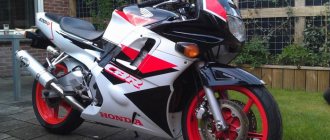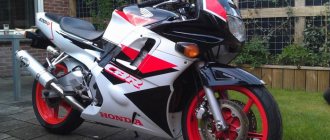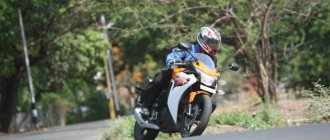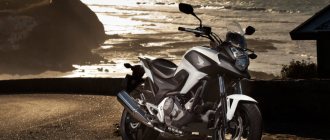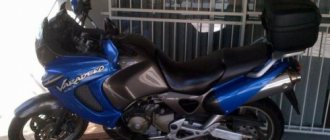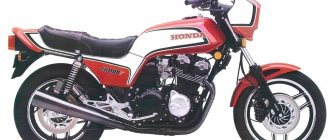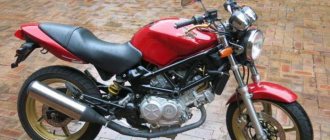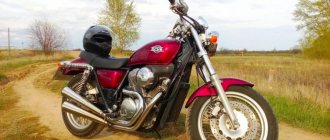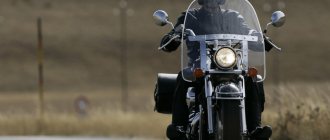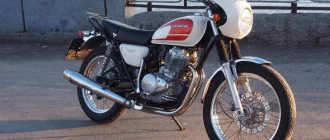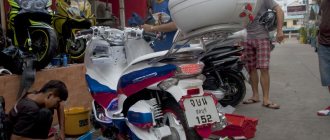Motorcycle Honda CBR 600 F4i has become one of the most successful models in the entire line of sports “six hundred” from . Its creators managed to find the perfect balance between design, technical characteristics, comfort, seasoning it all with branded reliability, and the cherry on the cake was moderate cost. The bike is still in great demand on the market, despite the fact that it has been discontinued for a long time - the updated model that replaced it has become a more radical sports bike, and because of this, it has lost some of the fans who are accustomed to using the Honda F4i Sport not only as a motorcycle for every day, but also as sports tourist. Indeed, this model is quite capable of long-distance travel, especially if you equip it with suitable tuning and plan a route along roads of normal quality.
Design
Taking the appearance of the carburetor F4 as a basis, Japanese designers slightly modified it, adding smoothness to the lines. As a result, the bike, which was outdated in appearance, sparkled with new colors, and it looks organic on the roads even now. The commercial success of the model, which was produced for five years, is largely due to its daring appearance with a massive front end and predatory contours of a plastic body kit. Although globally the design has remained virtually unchanged since the release of the Honda SBR 600 F2, that is, since the early 90s. But in F4 Ai it was revised, refined and adjusted to the changing requirements of capricious fashion.
Specifications
Strictly speaking, it was the Honda CBR 600 F4i Sport that became the latest modification in the line. After the cessation of its production, the company fell silent for five long years, after which it offered the buyer a completely new CBR 600 F, which has practically nothing in common with its predecessor, except for the name. At the same time, the capabilities of the old F4 are comparable to those of modern competitors, and on the road it will not yield to them. It's simple - for the Honda CBR600F, the technical characteristics were designed mainly by marketers, and for the previous model they were developed by engineers who thought about how to reduce production costs, not in the first place.
Engine
The Honda CBR600F4i engine was borrowed from the previous generation and is almost no different from it, with the exception of an injection power system instead of a carburetor. This is a proven in-line four with liquid cooling , even the power has not changed - 110 hp, 62 Nm of torque . The engine loves speed, and to achieve optimal dynamics it needs to be turned up to 10-12 thousand revolutions, but at the “bottoms” it also behaves tolerably, without the twitching characteristic of forced engines of small cubic capacity at the slightest turn of the throttle. Acceleration to 100 km/h takes, according to various sources, from 3 to 3.5 seconds , that is, the difference is within the error.
Transmission
The gearbox is also carried over from the Honda CBR600F4. This is a classic 6-speed transmission , operating absolutely silently and extremely clearly. Reviews from owners often mention that with timely maintenance, the unit does not cause problems at all, and many of them, over a hundred thousand kilometers, only had to change the clutch, which is actually a consumable.
Chassis and brakes
The alloy frame replaced the steel frame back in the days of production of the carburetor generation, and it went to the Honda CBR600F4i without any changes, which had a positive effect on the weight of the motorcycle. The brakes have also not been changed since the late 90s; the front wheel has two 296 mm discs with 4-piston calipers , and the rear wheel has one 220 mm disc with a 1-piston caliper. Unfortunately, ABS system is not provided , but in general the braking system is sufficiently effective. Moreover, the suspensions contribute to excellent handling, especially with proper tuning. The designers were generous with a fully adjustable 43 mm inverted fork and a rear monoshock (both produced by the famous HMAS brand), also with a full range of adjustments.
Electronics
The Honda CBR600F4i was produced at the beginning of the 21st century, when auxiliary systems had not yet been introduced into all components where they could be implemented. There are no “smart assistants”, traction controls, different engine operating modes and the like here – just good old mechanics with the necessary minimum of electronic components. In case of potential problems, this greatly simplifies troubleshooting, and there is no need for computer diagnostics at the dealer.
Weight and dimensions
The sportbike's curb weight is lower both than that of its predecessors and that of its successor, the CBR600F Sport, only 200 kg . This is not a record, but a decent indicator, so the power output of this model is not bad. And the ergonomics, thought out to the smallest detail, make it very convenient for bikers of any size, although especially tall motorcyclists should think about installing a higher windshield, otherwise they will face a powerful flow of wind into the helmet, from which they can only hide by lying on the tank.
Controllability
Ease of control is one of the strengths of the model. The Honda CBR 600 F4ai steers very easily and predictably, and this is not the case when “predictable” means “boring”. The sportbike maneuvers well both at minimum speed and at 150-180 km/h, and what sets it apart from most other sporty 600s is the smooth behavior of the engine at low speeds, which is very important for city driving.
Fuel consumption
According to official data, average gasoline consumption falls slightly short of 6 liters . In practice, this figure may differ significantly, both up and down. It all depends on the technical condition of a particular motorcycle, your riding style, fuel quality and a number of other factors. But for simplicity, you can focus on this figure.
Features of the Honda CBR 600 F4
Every detail of the Honda CBR 600 F4 motorcycle is made of very high quality and verified. The installed new engine, unlike liter models, does not tear the rubber, so you can drive it for more than 5,000 km. The oil level will not change even after 6,000 km, its consumption is zero.
The model has a soft suspension. Only after five years of using the motorcycle quite intensively did it become necessary to clean the filter, change the oil, and change the pads. The digital speedometer does not show more than 260 km/h. You can buy spare parts for the Honda CBR 600 F4 in almost any country, even in small towns. The model has excellent handling on any road surface and in various weather conditions.
Owners of the motorcycle call it a hassle-free, reliable sports bike. A powerful 4-cylinder engine can easily cover several hundred thousand kilometers, but only if you carry out diagnostics on time and periodically service the motorcycle at the right time and do not skip the required maintenance. Fuel consumption averages 6-7 liters. Torque reaches 66 Nm at 10,500 rpm. The model produces a maximum of 13,000-13,500 rpm.
The Honda CBR 600 F4 has a real sporty character. Exceptional, precise response to throttle inputs. The model allows you to perform sharp maneuvers with a strong body tilt, and this is a sign of an excellent controllable, reliable motorcycle. It has good dynamics. Manageability at a high level, attractive appearance. The frame is aluminum, so it is light, but reliable and strong. An effective braking system with C-ABS gives even beginners confidence on the road.
Motorcycle price
This model was produced from 2001 to 2006 , so the most recent copies are still almost a decade and a half old. So the price on the secondary market is low, 95% of offers are in the range from 200-220 to 300-330 thousand rubles . You need to choose very carefully - despite excellent reliability, a motorcycle still does not last forever, and in the hands of a careless owner it can quickly turn into junk on two wheels, and over the past years, the sportbike that you like has probably passed through many hands.
Repair and tuning
Affordable maintenance costs and ease of maintenance are another reason why this motorcycle is so popular. Not everyone has the desire or ability to spend money on visits to branded services, but this bike provides all the opportunities to do it in your own garage.
Repair
Honda TsBR F4 is a representative of an almost extinct class of fully repairable motorcycles. Almost all of its components can be repaired, and not simply replaced, unlike more modern technology. Do-it-yourself repairs are entirely possible if you have the appropriate skills. As a last resort, you can always contact any normal motorcycle service.
Spare parts
Most of the spare parts are suitable for the CBR 600F4, since the engines, gearboxes, chassis and many other components of these bikes are almost identical. Over the years of production, the Japanese company has riveted a huge number of models, so in general there are no problems with finding parts. You can always order new spare parts, original or not, or look for used ones, of which there are also plenty.
Tuning
There are a huge number of available tuning options; different companies offer interesting solutions even now, despite the fact that the Honda CBR600F4i has not been produced for a long time. Quickshifters, luggage systems, windshields, firmware for injectors - you can buy anything you want, not to mention little things like grips, mirrors, sliders and similar little things.
Honda CBR 600 F4 design
The Honda CBR 600 F4 has quite an attractive design. If necessary, you can change the fairings. There are red/black sets, yellow and other colors on sale. The ergonomics of the model allow the motorcyclist to sit in an upright posture, and the characteristics and steering capabilities do not require the person to put much weight on the handlebars. It is a sport concept completely adapted for urban use.
The spacious trunk allows you to take everything you need on a trip. Heated steering wheel grips make driving comfortable in cold weather. Additional casting of ribs on the inside of the frame increases lateral rigidity and elasticity. The shape of the double headlight is designed using computer software. She has an attractive appearance.
The model has two reflectors, they are installed on the left and right. The manufacturer used H7 55 Watt low and high beam lamps, which provides excellent illumination when driving at night. Honda СВR 600 F4 simply amazes with its original design and dynamics, which is visible in every line. The motorcycle has adjustable suspension and a wide rear wheel, unlike previous models in this line.
Practicality, comfort and elegance have become the hallmarks of all modifications of the CBR series motorcycles. These qualities are combined with a high level of comfort for the motorcyclist and passenger on a long trip, which is usually indicated by the letter F in the name. Excellent handling makes it suitable for experienced riders and beginner bikers.
The Honda CBR 600 F4 can be called one of the best in its class. Among the middle class of 600-750 cc motorcycles, this particular model is distinguished by its relatively low weight and small dimensions, good acceleration, handling, reliability, and their cost is more affordable and accessible than liter motorcycles. You can buy a Honda CBR 600 F4 for about 3 thousand US dollars.
Advantages and disadvantages
The Honda CBR600F4i turned out to be a very balanced motorcycle , but it shows an attempt by the designers to flirt with both the sportbike class and the sport-tourist class at the same time. But the result of this bold experiment turned out to be very worthy, although not without some specific shortcomings.
Advantages
- Incredible reliability . 100 thousand kilometers for this engine is far from the limit.
- Spacious gas tank , as much as 18 liters. On a long journey, you can safely count on a range of up to 300 km, if you don’t drive too fast.
- Excellent dynamics , comparable to the dynamics of “liter” sportbikes.
- Standardization with many other Honda models on a number of components, which makes it easier to find spare parts.
- level of comfort by class standards .
Flaws
- Lack of ABS , which does not go well with impressive dynamics.
- Weak light from the headlight . Most owners eliminate this drawback by replacing standard optics with xenon, but this is fraught with problems with the traffic police.
- When driving through traffic jams in the heat, the engine gets noticeably hot . He is not in danger of overheating, but his legs get hot.
- Small steering angle , which makes maneuvering at near-zero speeds difficult.
Owner reviews
An excellent bike, comfortable and convenient, after traveling 800+ km with short stops at a gas station, I didn’t even have the desire to warm up, nothing stiffened or hurt. The standard windshield is enough for my height (174 cm), up to 160 mph you can’t even lie on the tank, and it doesn’t blow. The seating position is close to classic, the load on the back and arms appears only when lying on the tank, that is, when driving at very high speeds, and I don’t drive like that. My cruiser on the highway is about 150-160, if you drive faster, fuel consumption increases sharply, but it fits within 6 liters quite well. I always use 92nd grade gasoline, everything is ok, preventive cleaning of the injector showed that the gasoline is good, no dirt was found. Sergey, Rostov-on-Don.
The model is ideal in many respects - the engine is torquey, comes to life after 7000 rpm, the suspension is complete stuffing with a set of adjustments, there are also enough brakes. If this model were still in production, I would take a new one without hesitation. I changed the bike myself in 2021, tried a tourenduro - it didn’t work for me, I started looking at sports again. The more recent Honda 600F didn’t work at all; I ended up taking the Fyzhera 1300, but it’s already a heavyweight compared to the F4i. Grigory, St. Petersburg.
I took it as my first moto, although I knew that it was not a toy, so I rode carefully. The first impression was not very good - the motor is rolly at low speeds, the engine is torsional, I was scared at first. Gradually I got used to it, began to fry it to the fullest, in three and a half seasons I wound up almost 40k, I drove with panniers at sea, and around Kazakhstan, and wherever I went. There were no serious breakdowns during the entire period, only minor ones that were inevitable due to the age of the bike. Alexander, Kazan.
Review of the Honda CBR600F motorcycle (CBR600F2, CBR600F3, CBR600F4, CBR600F4i)
I'm actually very pleased with the motorcycle. There are both disadvantages and advantages, but the disadvantages are more about comfort, and what kind of comfort is there... this is sport))) and speed. There are other motorcycles, you say for comfort and I agree.
The only problem is the timing chain tensioner (new 2590 RUR) which rings from 2000 to 5000 rpm. but it doesn't affect the circuit in any way. Factory defect in the tensioner itself. It can be treated by replacing it with a new one, the latest modification with the end of the catalog number J23 and two blue dots on the tensioner itself.
The box is excellent and quite soft, but everything is within normal limits. The gears shift smoothly and neutral is very easy to catch. I already own the second device of this brand and have never had any problems with the box. Very reliable, as is the engine. The engine is elastic, especially up to 7000 rpm. After 7 it gives heat, but again exactly without jerking and without fury, which forgives many mistakes. Maximum speed 260kmh. The headlight leaves much to be desired; it can be treated by replacing it with bi-xenon. The controls leave a very pleasant feeling. The motorcycle is quite light and maneuverable. There are no problems with handling in traffic on the highway or in the city. The mirrors are conveniently located on the front sides of the fairing body, there are no vibrations on the mirrors, all areas are visible quite well. Landing. It depends on who. I'm 180cm tall. It wasn’t very comfortable on long trips at high speeds; you have to lie down on the tank, but you can’t sit for that long and your back and arms become numb. Basically, the entire body weight is transferred to the hands and forearms, which quickly tires not only the arms but also the back. You can only relax with a straight back at a cruising speed of 120-140 km. If you want to drive 160 km/h or more, you will have to lie down on the tank. But I will add that I sat on many versions of sport bikes from different manufacturers when choosing a motorcycle and I will say that in terms of suspension stiffness, seat softness, seat comfort and compactness, this is the best motorcycle both for the track and for the city. Suspension. Excellent shock absorber, lots of adjustments. Customize it the way you want. The softness of the suspension is also compensated by the soft seat. The fifth point did not get tired even after 200 km. ride without getting off the motorcycle.
Overall, the bike is very nice, and for me, as a beginner, it was ideal for the first season. Up to 6 thousand there is just a calm acceleration, after which you get a good kick and the bike really starts to accelerate very quickly. It forgives many mistakes for a beginner and brings a lot of driving pleasure. During the season I drove it on two long distances (700 and 300 km one way). In principle, the back gets tired, of course, but not much (thanks to the divine landing). On the highway the bike behaves simply wonderful. At a speed of 220 km/h, lying on the tank, you understand that the bike is moving as if on rails and you can control it. It was possible to accelerate further, but I was afraid. Especially knowing the unpredictability of our roads.)))
As a result, I rode more than 10,000 km on it during the season. Average gasoline consumption was about 6 liters on the highway and a little more in the city. In traffic jams, of course, it heats up, but it doesn’t reach the point of overheating (fans save the day). For those who are going on a long trip on such a motorcycle, I would immediately advise you to change the original windshield. At speeds above 90 km/h you have to lean on the tank with it. And with a higher glass, you will be provided with comfort on long trips. That's probably all. Those. For me, the Siber was a universal device for city driving, long-distance driving, and for spectacular trips with my other half.
Honda CBR600F3. So sport or sport-tourist? At low speeds the device is extremely clumsy and difficult to control, the turning angle is small and the weight is not small, this is not the Sb1 on which I just flew in traffic jams. Because My device is highly tuned (nulevik, full forward flow, dynojet, gold jets - all this was tuned on a dyno, the total increase is about 10-12 hp), then there are practically no lows and the engine doesn’t pull from the bottom, but at the top it just shoots . In short, after an hour and a half in traffic jams, your back and arms are starting to ache, because the landing is not straight, and in order to drive normally in a traffic jam you have to straighten up, but it’s not a fetal position like in sports, here it’s something like a humane sports landing. Yes, and it’s not easy to throw up in a traffic jam; it always twitches at low levels and shoots at high ones.
But when driving out onto the highway you feel like a king, the tuned MPA windshield, even during a direct landing, does not allow the wind to strain the pilot, up to 170-180 km, then it begins to blow by the collar, if you lie on the tank, there is no discomfort at all, after driving 300 km you do not feel any fatigue . The device is heavy and there are no problems on the highway with a side wind, you can feel it, but the device clearly lies on its course. Trips to the track showed that the car handles excellently, can you go through a turn with a little elbow grease? — no question, it holds turns perfectly and the main thing is that you fully feel it, we tightened the suspension a little, but I think tighten them up and the problem should go away. Riding on the track just brings pleasure, and not the negative effects of fighting with the motorcycle for controllability. The motorcycle moves in bundles simply fabulously. The engine is like a clock, the gearbox too, braking with the engine is a pleasure, it feels like ordinary brakes are not needed.
And yet it’s not clear, is it a sport or a sport-tourist? on the one hand, there are glitches on the track and I think tightening up the suspensions will solve the problem of excessive softness, which also interferes in the city, and the brakes, most likely the pads and reinforced hoses on the front are just asking for it, in winter I’ll definitely take blue Nissin and reinforced hoses. By the way, this is one of the few motorcycles where my height (187 cm) fits comfortably and so does the passenger, while the clips and controls are always in place, and you can’t see yourself in the mirrors and you can see the road at 5+. But on the track this motorcycle was in no way inferior to the same f4i. The moto at medium speeds is quite peaceful and fluffy, but as soon as the needle goes past 10k, the moto instantly accelerates, unloading the front wheel. I rode a Vyfer750, rode a Jike 600 and a Siberian 600RR, I would say that this moto is 50% track, 30% city and 20 long range. Yes, it doesn’t bother you on long trips, but it provokes you to drive fast, and the tank is too small for very long trips (17 liters), taking into account its childish appetite after tuning. Still, this is more of a humane sport than a full-fledged sport-tourist; it’s not for nothing that the legendary Joe Dunlop won TT races on the Isle of Man with it more than once. I would recommend this device to people who haven’t decided what they need, a sport or a sport-tourist, this bike has good sports skills and, in principle, is not averse to covering long distances, but the question is how often do you plan to do this, after traveling through the season, I understand which is not often and for me now the F3 is the ideal motorcycle, I would like an injector and less weight like on the F4, but on the track the F4 is inferior, why? hmm, I don’t know, maybe this is my subjective opinion
Similar models
- Kawasaki ZX-6R. extremely popular sportbike that has gone through countless restylings and upgrades.
- Yamaha XJ6 Diversion F, also known as FZ-6R. An easy-to-handle and easy-going road warrior in the guise of a sports motorcycle.
- Suzuki GSX-600R. A much more “angry” and radical bike , which was created primarily for the race track, and not for everyday riding.
Chassis and brakes
The frame here is made of steel. Of course, such a motorcycle can only have cast wheels. The steering wheel is typical for the class. The entire exterior looks elegant and sporty, and in some places even futuristic, thanks to its streamlined shapes.
The suspension at the rear is a pendulum version with a monoshock absorber, while at the front there is an inverted fork measuring 41 mm. The rear brake features a 240 mm disc along with a single-piston caliper, while at the front there is a 296 mm dual disc with two-piston calipers.
FAQ
- How does it differ in fuel consumption compared to the carbureted F4? Insignificant, on average within 0.5-0.7 liters.
- With a height of 196 cm, won’t it be tight on him? In general, no, judging by the reviews of the owners. But in this case, you should immediately look for a windshield of increased height to avoid discomfort.
- I heard that its suspension is too soft for the track. This is true? Not really. Of course, this is not a radical sportbike like the Yamaha YZF-R1, but the suspension can be tuned to become much stiffer.
Conclusion
This model is a rare example of a successful experiment at the junction of two classes . Powerful enough and well-equipped for the track, it is perfect for the role of a motorcycle for every day, and it can handle long journeys too. Of course, it has its shortcomings, but they pale in comparison to its many advantages. Perhaps the only serious disadvantage of the Honda CBR600 F4i is the considerable age of all copies.
Specifications
| Maximum engine power: | 110.2 hp (81 kW at 12500 rpm) HP |
| Torque: | 10500 rpm (65 Nm) Nm |
| Working volume: | 599 cm3 |
| Motor type (cylinder arrangement, number of strokes): | In-line four-stroke engine |
| Number of cylinders: | 4 |
| Number of valves: | |
| Intake type (Injector / Carburetor): | |
| Bore and stroke: | |
| Starting system (Electric starter, kick starter): | |
| Maximum speed in km/h: | 251 km/h |
| Cooling system: | Liquid cooling fan |
| Transmission (gearbox): | 6-speed, Manual |
| Clutch (Dry / Wet): | |
| Drive unit: | Chain |
| Frame: | Aluminum twin-spar, box-section |
| Chassis | |
| Suspension (front/rear travel): | |
| Brakes (Front/Rear): | |
| Wheels / Tires / Rubber: | |
| Dimensions and weight | |
| Dimensions (Length / Width): | |
| Seat height: | |
| Ground clearance: | |
| Curb weight: | |
| Wheelbase: | 1390 mm |
| Weight: | 200 kg |
| Fuel tank capacity: | 18 l. |
| Battery capacity: | |
| Year of release: | |
| Country of Origin: |
Hello everyone, my dream has come true. K has come a long way to my ideal. here is the process from start to finish. I watched how people were blown away by such projects and went through it myself. From this:
Before this: My plan was to change from a supermoto to a road bike or a sports car, the main selection criteria were, in general, like everyone else, ease of fit, acceleration dynamics, fuel consumption. On the KTM640 everything was fine except for a maximum speed of 150 km, some dynamics after 100 km/h...
Of those motorcycles that, in my subjective opinion, were suitable motorcycles before 2004, manufacturers of the Japanese Four, Yamaha, Honda, Suzuki, Kawasaki. The class is only 600, but there is normal torque in the middle and at least some in the low end. As everyone knows, liters are more expensive, the consumption is simply outrageous, it boils wildly in traffic jams, and it has been realized to the full 30% of its potential.
The options I had were Ninja 636, CBR600 F2, F3, F4, GSXR 600, R6, Thundercat. The first important criterion is the lowest possible price and the availability of documents. I really didn’t want to communicate with police officers and lose money. The second criterion was that I really wanted a garage, since the dancing on my balcony was boring both me and my other half. In fact, I had 3,200 dead presidents, which limits the choice in general to either equipment or a garage.
I decided to go to roulette, buy a dead one, restore it and, for the other half of the money, buy a garage in a cooperative 5 km from the house. Well, bullshit, done, said done. The first option was 1 km from the house, but in such a condition, there are no screeds and no roof. Well, it’s logical that we need to water it again and again, light meter, screed, heating insulation, everything drags on a string of expenses, and endless waiting. I even foolishly gave a deposit, I had to realize it back.
The second option is 5 km from home. Looked something like this
For work, re-roof, clean the bottom of the gate that doesn't close, painted the floor, at least to make it less dusty. I bought a potbelly stove and did at least some semblance of insulation. Well, firewood. Shelves, in short, more and more work, but that will come later anyway.
Paid was 1000
On hand 1700 Out of the agony of choice, I was almost inclined not to buy the GPZ900R, an old piece of shit, 1987, my age and in a state of disrepair. Thank God it turned me off. The 2nd choice was random and, oddly enough, it fit, out of 600 there was 1 that was comfortable to drive, start and was also comfortable, CBR F2 600 1991.
The photos only show that it has been washed well; the front caliper disc is no longer immediately visible, but they are available. initially it was 2200, bargaining like an inveterate outbid, 1700.
2nd problem, I won’t be able to travel 700 km away to look, I’m wondering how lucky I was for the second time, to buy a pig in a poke. The purchase path consisted of sending scans, the owner gave a certificate with the right to change. I didn’t pay the TP company, I just sent the dock number and registration certificate. And this is what I got, a rather old, time-worn motorcycle that was beaten. And I think that once, but not a problem, I expected this and was ready. There were so many “nuances” and “sonnets” in it that I couldn’t even grasp them at first. The documents are clean, that's lucky.
And as I later found out, it was sold before and it looked a little different:
They chased him poor... And dropped him 
Plastic, face, made of fiberglass, half broken, a couple of pieces of the rear missing, the wing is dangling, electric... guard, collective farm and selective. The one who did this crap, I’m sure you are “chasing trams with a pitchfork,” there is a way out for turn signals from the remote control, but there is no way out in the spit, a paradox.
As a result, I counted and now I’m telling you what needs to be replaced.
All plastic is in repair, all 13 spare parts, 3 are simply missing. Bearings in the wheels are tightly dead, that’s all. Headlight not original Bent spider Braid wiring collective farm Brake disc 1n and the same as foil 2nd no Caliper 1 piece, not working soured 2nd no Pads all around 3 sets No rubber as such. There are no turns to begin with. There are physically no turn signals themselves. The remote controls need to be replaced. The steering column bearings need to be replaced. The fork didn’t just leak, but pissed from all the cracks. Unstable idling Unstable acceleration Tensioner, I thought it would break the fuck off at the first start Timing chain clanging Noise in the cylinder head (gaps, washers there) Rubber, bald even to the “court” almost Grips torn And the brake machine is leaking Bent footpegs Air filter is terribly dirty In the engine not oil but “nigrol”
The previous owner then sent stickers and wiring, but it didn’t fit from the F3 and there is an electronic panel, a speed sensor in the box, and a brake disc and caliper
Here, as they say, having realized the depth of my ass, I doubted it, but still decided to take this step. I already have experience in restoration, there are posts on my profile, I have experience in collecting ready-made equipment from a bag.
It all started with the fact that I bought plastic, as a set, it came with factory turns, the condition was better, but it also required some fine-tuning efforts. I spent 4 months on it in the evenings assembling it at home.
Next, winter, -12 in the garage, it was very difficult to glue the back parts in place, a hairdryer would help
When I finished with the whole thing, the preparation, a tedious, labor-intensive process, which took all this time, about a month.
The fork replaced the bearings in the column, I used AllBalls and the fork repair kit is also AllBalls. As it turned out later there are several types of cartridges, a bunch of spare parts were left lying around.
Fork oil, not for the sake of advertising, Agip 10W performs well and withstands temperature fluctuations very well. Price 5
A cable braid and 2 remote controls were ordered from Poland.
Quite by accident I came across a headlight from my motorcycle, I bought it at a disassembly for cheap
From Japan, I ordered an original chain tensioner and a timing chain 110, 12 of which are only money transfer and delivery 20, total real cost 80
Original brake discs cost a hell of a lot, something like 260 per pair, but I’m not a fool to pay that amount just for them, as a result, there is a craftsman made from 65G steel, which is used on friction clutches of steam locomotives for 100 a pair.
Having twirled the calipers in my hands, which were junk, I realized that I needed to come up with something and realized that I needed to make the brakes “brighter”; I had a custom project for tomosis that would be installed on the Hornet 900, and from the F4 F4i, I made it from 45 steel spacers, and from pieces of the corner the squalor that is in the photo below,
Having tried it on with a critical eye, I realized that all this should be thrown into a landfill, and not a waste. and took me to the metal processing shop, where they made 2 adapters for me.
And at the same time I painted them
I was collecting and playing with plastic, I freaked out, I ordered a spider from Poland, price 50
I chose the paint like the one on the Toyota Camry 2021, white xeralic, it’s expensive and rich.
They started offering me $20 for 20 grams for Xeral. I squeezed it honestly. For $3 I bought mother-of-pearl with a golden shimmer, well, a liter of the hardest varnish.
Well, the painting process began. In the garage I bought, I made conditions that are similar, but in no way correspond to what is needed.
Since I’m a handyman, I didn’t paint some parts that weren’t particularly visible, I filled them with varnish, but managed to under-dry and undermine the coating. quiet horror... Well, okay, there’s no time, go for a ride... Although it’s gnawing...
Well, at this point we could finish showing the finished photo. But what the heck. Naturally, I did not calm down. The main problem was the brakes due to a faulty brake machine, a caliper from the 4th model, but the machine, and the design of the disc as well as the diameter, did not allow it to be realized. I had to return to the original brake system, because the discs would have been more expensive. Calipers with pads were ordered from Poland. And a brake machine, obviously working.
From time to time I was riding on a motorcycle, I managed to tighten the oil drain bolt and break the aluminum, I took it off, oh and cursed and screamed and freaked out, in short, the cook doesn’t flow normally. I decided to try the oil on my own, iPone 10.4 10-40W and a gift of chain lube. My opinion is absolutely unequivocal.
Then, after all the dancing, it was time to change the timing belt, I pulled the cat by the tail until the last minute. I decided to call the service, you won’t believe it. About 20 services, all refused, as I understand it, it’s narrow, there’s not enough space, it’s a hassle, it’s not profitable. Everything as usual…
We remove the news plastic, tank, muzzle. We remove the coils, the rubber boot under the tank, and release the radiator. And remove the cylinder head cover. We look at the marks, T at 0, the shafts are horizontal with a cover. We loosen the camshafts, strictly exhaust then intake, remove the tensioner, use a crowbar to pull the exhaust camshaft on the left and the yoke with it jumps off, then the intake as well. Then we turn the knee so that the ignition comb is towards the top, then the timing chain will come out from below without removing the ignition. Nothing interesting further, I measured the gaps under the camshafts, I will say this, there was no point in measuring the marks. Everything is like from the factory. Before installing the tensioner, I threw it into a glass of oil, squeezing it all the way, then when I put it on I barely squeezed it, but that’s not the point. Assembling in exactly the reverse order, stretched the chain, baited it, aligned the shafts, clamped it... and made the wrong mark. I took it apart again and reassembled it again, it’s hard to guess, the exhaust camshaft is at TDC “cancer”, I calculated how the Kawasaki manual between the teeth or marks will describe how many teeth from mark to mark, there are figurines here. Well, that's not the point.
I realized that things are bad when there are no bearings... and changed them all)
Having finished dancing with the tambourine, he collected everything and went for a ride. People say the color of the wheels doesn’t suit me, I agreed from the start, well, black doesn’t look right at all. Sandblast and powder. I thought the mother-of-pearl turned out to be poured so-so, to be honest, the shine is so-so.
As you can see, the color varies, but the motorcycle has finally taken on the appearance of equipment rather than shit.
But I still have something to strive for, for example this option.
By the way, if anyone is interested, it will fit from VFR 750 to 800 no.
Before the winter and everything else, I had a very bad nightmare about a fight in the garage, so I made up my mind and did it...
This is what it looks like now
Well, in general, I put everything in order, I walked around it, and thought something was wrong. The main problem of a pedant, represented by me, is a good painting of a toy. Polished triple clamps, polished fork and calipers. But seeing in themselves the unwillingness of services to work with plastic, it’s terrible how they don’t want to, they want to paint a poor bumper with a flat shelf, and nothing else. I came to the conclusion that it is Chinese painted plastic.
I ordered it and it arrived. I thought a lot and was very upset just as much. The main problem with Chinese plastic is “broom” painting.
In addition, at the time of replacing the plastic, I really didn’t like the appearance of the frame and the motor, I decided to take a responsible step, first repainted the motor, and then the pendulum and frame. In regular black. I’ll answer, I have a bad back and the engine weighs 87 kg.
After all this, I also tinted the “hager” in a neutral anthracite color, although I really wanted black, but that’s how it turned out.
At the same time I replaced the cooling pipes with silicone pipes, quite nice. I changed the cables, throttle and choke, and the clutch.
Well, I finally replaced the rusty exhaust system with a stainless steel prefabricated exhaust, and unfortunately welded a direct-flow exhaust without a flute, so you stall, which I regret, I plan to replace it with an old can, from an Aprilia RSV 1000, quiet and comfortable.
I immediately ask if anyone is interested in where I got this exhaust, I don’t own it, I got it by accident, the collector without a can cost me $100
Well, the final touch was replacing the pan, since I tightened the oil drain bolt, well, you understand...
Now the bike looks like this:
and there is nothing in the immediate plans, I’ll most likely ride this summer, but for the winter, I have a couple of ideas, I have a complete motor, from a CBF600 2004 PC38 for 80 horses, and a frame from Izha. I think that I have grown up, I have ideas.
Until next time.
